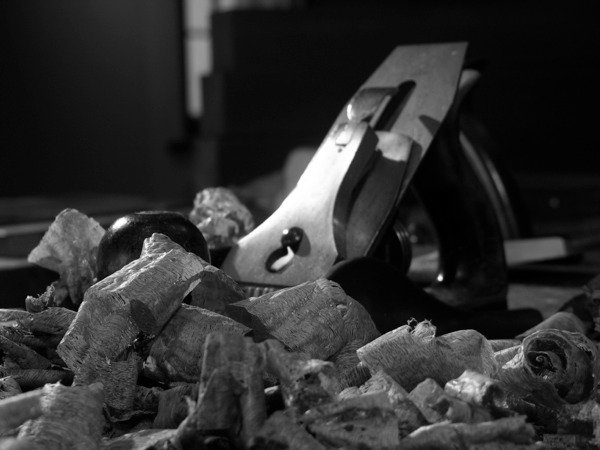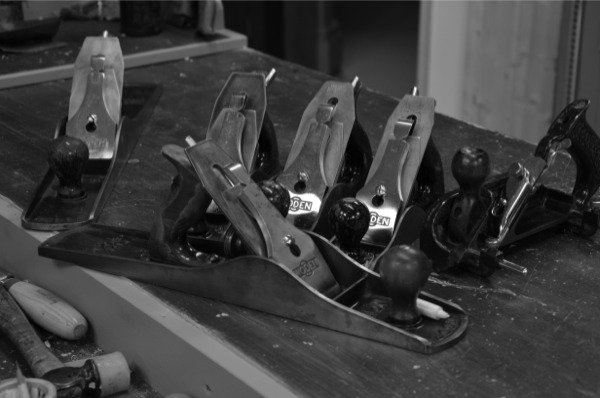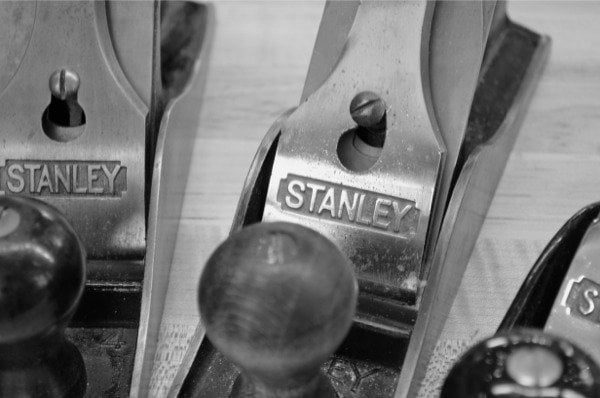Planes Speak for Themselves
For more information on planes, see our beginner site Common Woodworking.
Seems to me sometimes that what was once ordinary and common is now more a sort of coffee-obsessing where discussing replaces making and tasting the coffee itself. I think you know the type of thing. Two or three people start talking about their favourite coffee and the conversation heightens in pitch as each party obsesses about what they like the most in a coffee until the discussion diversifies into what water should be used and what temperature the water should reach before perking the coffee. Does alluminium influence the flavour more than stainless steel and are paper filters better than even silk? 





Thank you for your common sense approach to the craft.
The main thing wooden plane users rejected the cast metal planes and other metal bodied or metal soled planes was that metal “sticks” to the wood. The second reason was weight. A wooden plane feels at least half the weight of a metal one and yet today it seems the weight is offered as a strong point for buying one when in reality it is more counterproductive than productive to lug around a heavy plane.
Hear, hear! Robin Lee, are you listening?
Mr Paul Sellers:
Yesterday, I got help (basically telling me what to do!) from a men around 95 years old, to prune e few fruit trees at my house.
This man had almost no school education, barely knows how to read. He made is entire living around trees (these days i believe it’s called an “arborist man”) and farming.
The most interesting things he told/teached me were:
-the different ways he should look at trees, kind of looking with “other pair of eyes” or some special glasses;
-and when i asked about is tools, he just told me, that we can work with almost any tool, just needs to be sharpen. “…at the end of the day, the last thing i did, was clean and sharpen my saws, axes, and then i put a bit of olive oil. Its ours hands that makes the job done…”
Of course that some tools helps more than others…
But wood crafts are Just like you write Mr Sellers, understanding wood and SKILLS – lots of skills!
Thank You for your work!
P.s. I think i’ll copy that idea i saw in the first picture for my new (40 something years) Stanley #78 duplex rabbet plane!
Paul,
I acquired a transitional foreplane but the tote is broken and the blade has a beautiful “spalted” pattern corroded into it. I previously cobbled together a wooden jointer plane as a mock up. The blade for the home made plane is flat o1 from lee valley. I really prefer the glide of wood on wood and would like to make a basic small set of wooden planes. Would you recommend tapered irons, or would an iron with a cap iron work better as long as the cap iron was not humped?
Thank you
As an afterthought, maybe one of the current plane makers could make transitional kits for which we provide the wood?
I think that that would be just brilliant!!! Contact Robin Lee at Lee Valley Veritas. Tell him I think this is a great idea and suggested you contact him. He has a dynamic plane and tool design team. I know that he would listen to you. He’s a very respected guy.
I was just seeing the “landscape” and i saw this kit.
Could it be something like this?
http://www.leevalley.com/US/wood/page.aspx?p=71379&cat=1,230,41182,46334
Or more developed?
Either way works fine. I make my own irons from rolled flat stock and as long as the wedge is rightly fitted find that they stey in place fine. A cutting iron costs around $3-4 that way. We just did a series on making planes as part of making the workbench stool seat series for woodworkingmasterclasses.com .
Hi Paul
Notice you have a full set of Woden’s in one of the photograph’s in this post. I bought a No4 Woden from my daughters primary school charity auction, i made the only and highest bit of £15 for it. I had never heard of Woden but was suprised when came in a cardboard box with a leaflet which has a telegram address and a 4 digit phone number!
It’s been well looked after but blade was well worn so replaced it with a hock, after a tune up, great plane.
Only thing is, i have not found much on the internet about the history of the company other than it started producing after WWII and was swallowed up by a larger company in the late 60’s, even though the leaflet says and di quote ”for over 100 years Woden has been the choice of the discriminating craftsman who demands the best”
Was wondering if you had heard/knew more about Woden, was also wondering what colour the handles are on yours as mine have a very bright reddish varnish?
I will try to get to this later, Edward. Some say it was an inferior line owned by Record, but the planes I have are very much superior in quality so that’s not true. I knew some craftsmen that owned them in the late 50’s so that would have been after WWII.
Thanks Paul
Would be very interesting to know more. I would certainly buy another one if i saw one come up as mine is as you say superior in quality, but they are pretty rare around the antique shops in my area (read none) and on the online shops like old tools etc.
Dont like buying second ahnd on the net, but am now off to ebay to try my luck anyway!.
Thanks for the great blog as always.
Thanks for the great blog
Damn computer, i should probably learn to type, or proof read, or something!!!!
Paul, if you use & like wiki (as I do) then you may wish to read – and perhaps update – this article on bedrock planes: https://en.wikipedia.org/wiki/Bedrock_plane
It makes several questionable assertions: such as Bedrocks being better than Bailey, thicker irons being better than thin, Bailey planes chattering, etc. The associated “Talk”-tab even goes as far as to claim the article is not at all controvertial! “There is nothing controversial or likely to be contested here.”!
I I confess, I do get tired of the piffle surrounding Bedrocks being the better planes than Bailey patterns. They were not. That’s why craftsmen users rarely upgraded or changed at all when the Bed Rocks came out and why so few were sold. What I will concede is that the more modern manufacturers, none of whom came up with anything new, improved the engineering and possibly some of the steel alloys. They charge extortionately for that, even though they invented nothing, which is their entitlement, so no great shakes there. What no one ever, ever, ever mentions, and it is a major downside, is that when you do alter the throat opening to a different distance, you also automatically alter the depth of the cut. This can be catastrophic if you close the throat opening because this then sends the cutting iron deeper. The other thing is the fake news that Bailey patterns “chatter”. Every one of the Bed Rock makers uses the statement, “prevents chatter” somewhere in their blurb but they don’t actually chatter! They never did! Had this been an issue would hundreds of thousands of craftsmen working with them from the late 1800s to the mid 1900s every day have continued using them and not upgraded? The famous misquote used too much is that “Everyone is entitled to their opinion.” The true quote is, “Everyone is entitled to their opinion but not his own facts.” You like wiki. I dislike wiki more than I like it for this very reason.